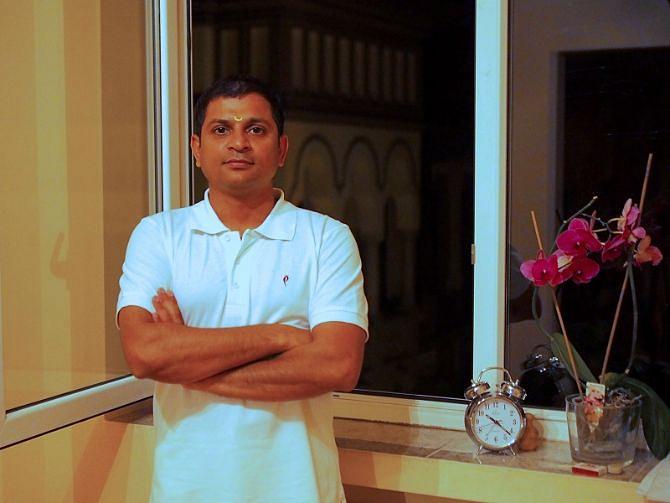The pursuit of happiness and the true meaning of a cup

On the second floor of an apartment building in the center Bucharest lives an Indian teacher of Hinduism and a former TV personality.
“Enjoy the feeling of being effortless,” says Yogeshvar Karthik, in a calm, firm voice. Some noisy birds chirp outside the open window, as the Yoga students try to relax and focus on the postures. Yogeshvar moves across the room and gives various indications about the correct position, or the right way to breathe.
Born in Chennai, the capital city of the Indian state of Tamil Nadu, in a Brahmin family, Yogeshvar lives now in an apartment close to the Cismigiu Park in Bucharest. It’s here where he also teaches his Yoga and Vedanta classes. But he doesn’t consider himself a Yoga teacher. “Yoga is only one of the things. I teach Hinduism. I teach Vedanta. Yoga is an accessory of Vedanta. Vedanta is spiritual knowledge.”
One can get confused with all these notions, but luckily Yogeshvar has a lot of practice in explaining subtle, complex concepts of Hinduism even to absolute beginners - even to a non-spiritual Romanian-born girl. In India he had a TV show for many years, where he taught Yoga and explained the theory behind. He says that even in the land where Yoga was born, people lack the correct understanding, and nowadays it’s seen more like fitness and sports, rather than a spiritual method.
Add to that the fact that Yogeshvar belongs to the Brahmin class- the priests class- so he had been introduced to all this long long time ago by his father. In most Brahmin families, children are initiated into the ritual when they are 6 or 7, but his family is “semi-modernized, as he calls it, so his initiation was delayed until he was 13-year old. But ever since, he has practiced the ritual every day. “It was an initiation into a way of life that includes a lot of discipline and practice.” He wasn’t totally spiritual from childhood, but he enjoyed doing the ritual. “It’s like in Christianity, when a small boy goes to church, and he gets the opportunity to be the altar boy, and there are shiny things; he will love it.”
But now, wearing a white t-shirt and white trousers, he takes the cup in front of me, that I used to drink a great herbal tea, which is served to all the students after the Yoga class, and says:
“What is this? It’s a cup, if I want to drink something from it, but it becomes a projectile if I become angry. At that moment of anger I don’t see this as a cup, but as a projectile.Then let’s say I have a small nut to crack, a pistachio. I can use this cup as a hammer. But what is it? It is all that and more than that. Basically it’s clay. If I show this to a quantum physicist he will say, this is an idea, not even clay.”
Then he adds: “What is this depends on what you want out of this. Similarly with reality. Spirituality talks about reality for you, and it’s about learning to relate to reality, in a way that it’s meaningful to me. So first I need to figure out what I want, then spirituality comes to tell you how to get what you want, without losing your head.That’s how it starts.Then it takes you to more complex aspects.”
People want happiness, but they are not happy
Birds in the Cismigiu Park go on singing, drumming, winnowing, and otherwise displaying, during the Yoga class. It’s through their songs that they are trying to impress and attract a mate and proclaim territories- not that much different from what people do everyday, running around after happiness. But in the pursuit of being happy, people only seldom manage to actually get there.
One of the reasons is that people are doing everything based on what they like and dislike, and in the process of getting what they want, they forget what is right and what is wrong, Yogeshvar explains. “People want happiness, but they are not happy. In this effort life becomes more and more unsustainable.”
I tell Yogeshvar that it’s rather difficult and probably subjective saying what it’s right and what it’s wrong, but he answers: “It's difficult, yeah, but that's why we are humans, we have a prefrontal cortex. We are not dogs. A dog has no choice. Freedom is not doing whatever you want - that is only one side of freedom; the other side is not doing something it if it's not appropriate.”
For most our questions, we have the common sense to tell ourselves what is right. On the next level there is science, and then comes spiritual knowledge. “With common sense you can solve most of the problems, you don't need the scriptures. But where the common sense and science give no answer, that’s where the spiritual knowledge comes in.”
No personal wealth and missing the Gange
Yogeshvar wanted to become many things when he was a kid: an aeronautical engineer, an army man, a monk, and then he came to the idea to become a wandering mystique, a person who belongs nowhere, but belongs everywhere. He liked the idea that genuine spirituality is hidden and became attached to the concept of a siddhar, a saint or a mystique who secretly guides the spirituality, without other people knowing it.
As a teacher of Hinduism who is a Brahmin, Yogeshvar says he doesn't have any personal wealth. He doesn’t have a bank account, he doesn’t make money, and the donations sustain the organisation called Vedic Dharma, that organizes the classes. He spends his days studying, meeting people who want to talk to him, preparing for the classes, or just walking.
“Not only as a teacher, but as a person committed to spiritual freedom, you don’t actively seek a situation for your happiness. I do something because it is to be done, not because it makes me happy” he says. “So you don’t really ask yourself in the morning if you are happy or not?”, I ask him. “That question does not arise. In the morning I just enjoy the silence, the wakefulness, and I probably do some meditation, or a prayer, that’s it.”
He came to Romania because the chief executive of a company asked Yogeshvar to help him set up his private retreat place- an ashram, and he thought that Romania could be a good place. And somehow he stayed here for longer. He doesn’t miss India, because spirituality is universal, he says, but he does miss the ability to do some rituals that can only be done there...and once in a while, he does miss the Ganges river.”I don't feel alienated because I have a lot of people coming, I have a role to play, I am their teacher.”
During the class, for about two hours, people do not check their phones, their Facebook updates, nor do they talk at all. They most certainly don’t share the same definition of Yoga, nor the same understanding, but they all take part in the personal effort of focusing their mind.
“People come to Yoga to find harmony and peace of mind, to handle their emotions better,” says Yogeshvar. “Yoga is an accessory for knowledge, even for secular knowledge. If you want to study well, you need a disciplined mind, a mind that is available for the knowledge. Yoga helps you develop your objectivity and concentration.”
Then he adds: “But what Yoga actually means is keeping the big picture in mind in every small action.”
By Diana Mesesan, features writer, diana@romania-insider.com
(photo by Diana Mesesan)













